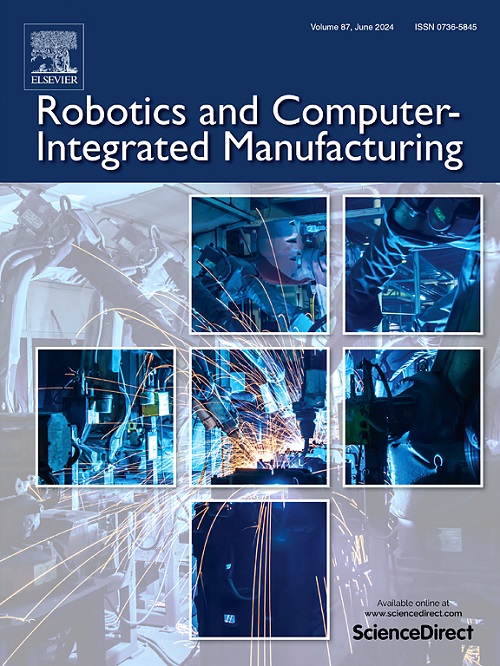Synthesis and prototyping of a backdrivable parallel robot for metal finishing tasks
IF 9.1
1区 计算机科学
Q1 COMPUTER SCIENCE, INTERDISCIPLINARY APPLICATIONS
引用次数: 0
Abstract
This article presents the synthesis, control and experimental validation of a backdrivable three-degree-of-freedom translational mini robot used to control the interaction between a robot and a machined part during finishing tasks, such as polishing, sanding and deburring without requiring the use of a force/torque sensor. The mini robot acts as an active contact flange, allowing an industrial robot (the macro robot) to adapt to a part using an impedance control algorithm. Firstly, different three-degree-of-freedom parallel robot architectures are compared and the most suitable architecture is selected. Geometrical properties are chosen for the robot and the physical capabilities of the architecture are predicted to ensure that the design criteria are satisfied. An impedance control algorithm is then developed for the mini robot. The macro-mini system is formed by installing the mini robot on a gantry robot. Sanding tests are carried out in order to validate the performance of the system and the mini robot is compared to other contact flanges already available on the market. Finally, a method allowing the determination of the magnitude of the friction forces in the mini robot is presented and a preliminary friction compensation algorithm is developed. As opposed to existing tools, the novel mini robot proposed in this work is based on a compact parallel architecture, which makes it possible to ensure the backdrivability of the system in three directions. An impedance control algorithm can therefore be implemented thereby providing stability even with stiff environments and eliminating the need for a force/torque sensor.
金属精加工后向驱动并联机器人的合成与原型设计
本文介绍了一种可反向驱动的三自由度平移微型机器人的合成、控制和实验验证,该机器人用于控制机器人与加工零件在抛光、磨砂和去毛刺等完成任务期间的相互作用,而不需要使用力/扭矩传感器。微型机器人充当主动接触法兰,允许工业机器人(宏观机器人)使用阻抗控制算法来适应零件。首先,对不同的三自由度并联机器人结构进行比较,选择最合适的结构;对机器人的几何特性进行了选择,并对结构的物理性能进行了预测,以确保满足设计标准。在此基础上,提出了微型机器人的阻抗控制算法。将微型机器人安装在龙门机器人上,形成大微型系统。为了验证系统的性能,进行了磨砂试验,并将微型机器人与市场上已有的其他接触法兰进行了比较。最后,提出了一种确定微型机器人摩擦力大小的方法,并提出了初步的摩擦补偿算法。与现有的工具相反,本工作中提出的新型微型机器人基于紧凑的并行架构,这使得可以确保系统在三个方向上的反驾驶性。因此,可以实现阻抗控制算法,从而即使在僵硬的环境中也能提供稳定性,并且消除了对力/扭矩传感器的需求。
本文章由计算机程序翻译,如有差异,请以英文原文为准。
求助全文
约1分钟内获得全文
求助全文
来源期刊
CiteScore
24.10
自引率
13.50%
发文量
160
审稿时长
50 days
期刊介绍:
The journal, Robotics and Computer-Integrated Manufacturing, focuses on sharing research applications that contribute to the development of new or enhanced robotics, manufacturing technologies, and innovative manufacturing strategies that are relevant to industry. Papers that combine theory and experimental validation are preferred, while review papers on current robotics and manufacturing issues are also considered. However, papers on traditional machining processes, modeling and simulation, supply chain management, and resource optimization are generally not within the scope of the journal, as there are more appropriate journals for these topics. Similarly, papers that are overly theoretical or mathematical will be directed to other suitable journals. The journal welcomes original papers in areas such as industrial robotics, human-robot collaboration in manufacturing, cloud-based manufacturing, cyber-physical production systems, big data analytics in manufacturing, smart mechatronics, machine learning, adaptive and sustainable manufacturing, and other fields involving unique manufacturing technologies.

 求助内容:
求助内容: 应助结果提醒方式:
应助结果提醒方式:


